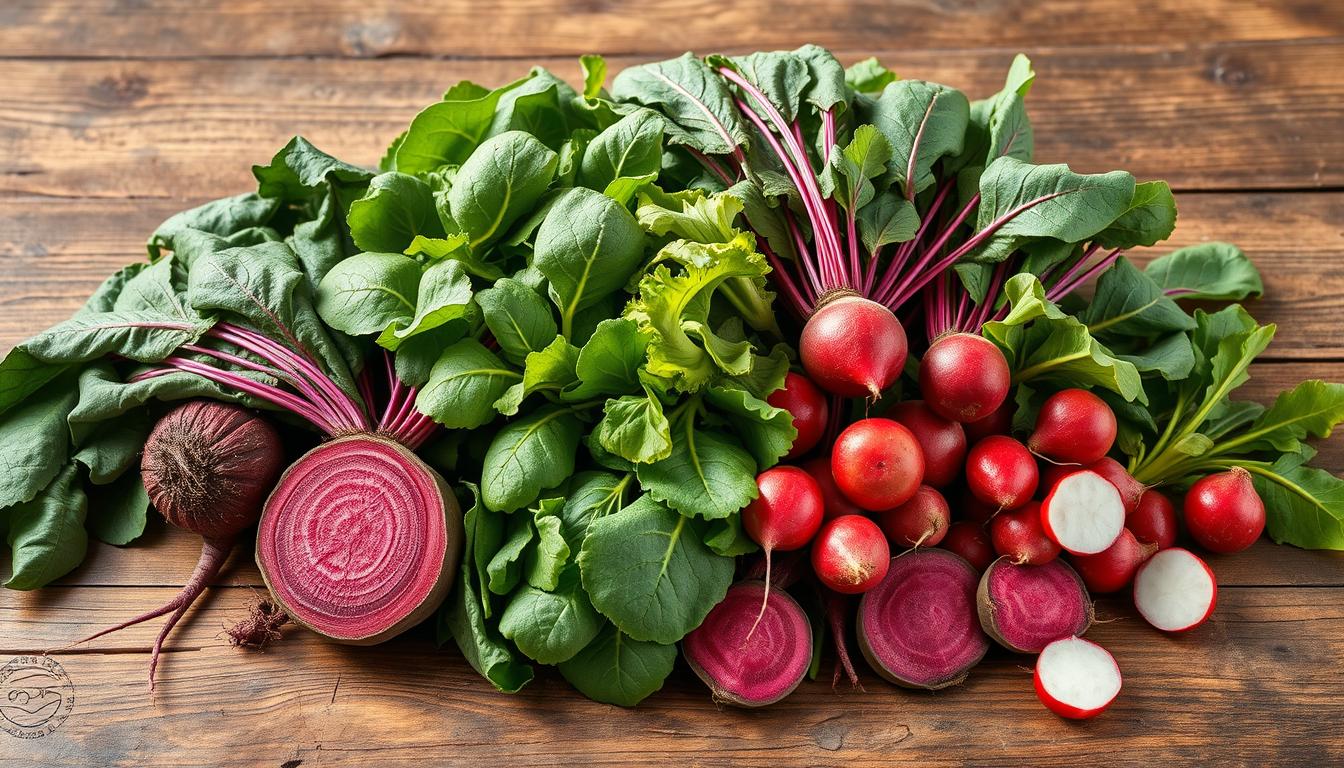Ever wondered how to boost your performance without relying on synthetic supplements? The answer lies in what you eat. Certain natural sources can significantly improve your energy levels and stamina during workouts.
These options help your body produce nitric oxide, a molecule that enhances blood flow and oxygen delivery. This means better endurance and faster recovery. Science shows that consuming specific items can increase nitric oxide levels by 21% in just 45 minutes.
Whether you’re a casual gym-goer or a professional athlete, incorporating these choices into your diet can give you a real edge. Ready to learn how to fuel your body the natural way? Let’s dive in!
Introduction to Nitrate-Rich Foods and Endurance
What if your next workout could feel easier and more efficient? The secret lies in your diet. Certain natural choices can significantly boost your stamina and recovery. These items help your body produce nitric oxide, a molecule that improves blood flow and oxygen delivery.
Your bloodstream holds the key to endurance exercise performance. Specific foods optimize it by enhancing nitric oxide levels. A 2016 study found that just 100mL of beet juice can significantly increase nitric oxide. This leads to better oxygen use and energy output during physical activity.

Why does this matter? Blood vessel dilation is crucial for sustained energy. It’s more impactful than relying solely on carbs. Simple dietary changes can improve your VO2 max and recovery times. A 2021 meta-analysis of 118 studies confirmed these benefits.
Olympic athletes and weekend warriors alike use food chemistry to their advantage. Strategic meal timing can act as a form of “natural doping.” By incorporating these choices, you can unlock your full potential.
| Benefit | How It Works |
|---|---|
| Improved Blood Flow | Nitric oxide relaxes blood vessels, enhancing oxygen delivery. |
| Increased Stamina | Better oxygen use boosts endurance exercise performance. |
| Faster Recovery | Enhanced blood flow reduces muscle soreness and fatigue. |
Ready to transform your workouts? Start by understanding how these foods work. The science is clear, and the results are worth it.
What Are Nitrate-Rich Foods?
Looking for a natural way to fuel your workouts? Start with what’s on your plate. Certain sources are packed with dietary nitrates, which your body converts into nitric oxide. This process helps improve blood flow and oxygen delivery, giving you a performance boost.
Not all vegetables are created equal. Some pack a stronger nitrate punch than others. Beets, for example, can increase nitric oxide levels by 21% in just 45 minutes. Leafy greens and watermelon are also excellent choices.
Here’s how it works: When you eat these foods, nitrates are converted into nitric oxide in your body. This molecule relaxes blood vessels, enhancing oxygen delivery to your muscles. The result? Better stamina and faster recovery.
Did you know farming methods can affect nitrate content? Organic produce often has higher levels compared to conventionally grown options. Choosing organic can give you an extra edge.
Check out this cheat sheet to see how much nitrate is in common servings:
| Food | Nitrate Content (mg per 100g) |
|---|---|
| Beets | 110 |
| Spinach | 85 |
| Watermelon | 60 |
| Arugula | 480 |
Ready to upgrade your diet? Start with these sources and feel the difference in your workouts.
How Nitrates Improve Endurance
Want to unlock a secret weapon for better workouts? It’s all about how your body uses oxygen. Nitrates play a key role in enhancing your performance naturally. Let’s break it down.
When you consume nitrates, your body converts them into nitric oxide. This molecule relaxes blood vessels, improving blood flow. The effect? More oxygen reaches your muscles, helping them work efficiently.
Here’s the science: Nitrates reduce the oxygen cost of ATP production. ATP is your body’s energy currency. By making ATP production more efficient, nitrates help your muscles use oxygen better. Studies show this can improve muscle efficiency by 5-8%.
Why does this matter for athletes? Better oxygen use means:
- Longer, more intense workouts without fatigue.
- Faster recovery times between sessions.
- Improved mitochondrial efficiency, the powerhouse of your cells.
This effect isn’t just theoretical. Real-world data shows typical performance improvements across sports. Runners, cyclists, and swimmers all benefit from enhanced oxygen delivery.
So, how does it work? Here’s the 3-step process:
- You eat nitrate-rich vegetables.
- Your body converts nitrates into nitric oxide.
- Nitric oxide boosts blood flow and oxygen delivery to muscles.
This simple yet powerful process is why endurance athletes care about nitric oxide production. It’s a natural way to fuel your body for peak performance.
Top Nitrate-Rich Foods for Endurance
Curious about the best natural options to fuel your workouts? Let’s explore three powerhouse choices that can elevate your performance. These items are packed with nitrates, which your body converts into nitric oxide for better blood flow and stamina.
Beets: A Powerhouse of Nitrates
Beets are a top choice for athletes. They’re rich in nitrates, which boost nitric oxide production. This helps improve oxygen delivery to your muscles, making workouts feel easier.
Studies show that consuming beets can enhance performance by up to 5%. Whether roasted, juiced, or blended into a smoothie, they’re a versatile addition to your diet.
Leafy Greens: Essential for Nitrate Intake
Spinach, arugula, and kale are excellent sources of nitrates. These greens not only support nitric oxide production but also provide essential vitamins and minerals.
Adding a handful of leafy greens to your meals can make a big difference. They’re easy to incorporate into salads, smoothies, or even as a side dish.
Watermelon: A Refreshing Source of Nitrates
Watermelon isn’t just hydrating—it’s also a great source of nitrates. Its high water content makes it perfect for post-workout recovery. Plus, it’s packed with citrulline, which converts to arginine, further boosting nitric oxide levels.
Research shows that 300mL of watermelon juice can improve bioavailability, making it an effective choice for athletes. Whether you prefer it fresh or as watermelon juice supplementation, it’s a delicious way to fuel your body.
- Seedless vs. seeded watermelon: Both are effective, but seedless options are often more convenient.
- Hydration bonus: Combining fluid and nitrate intake makes watermelon a smart choice for active individuals.
- Seasonal availability: Stock up during summer or freeze chunks for year-round use.
Ready to try these options? Start with a post-workout smoothie featuring beets, spinach, and watermelon. It’s a simple way to boost your performance naturally.
Scientific Evidence Supporting Nitrate-Rich Foods
What does the latest research reveal about enhancing stamina naturally? A 2021 systematic review of 118 studies provides some answers. This analysis included 1,872 participants and found trivial but significant benefits from consuming certain dietary choices.
Why do some studies show no effect? Population differences play a big role. For example, highly trained athletes may see fewer benefits compared to casual gym-goers. The science suggests that once you hit a certain fitness level, the advantages start to diminish.
Gender also matters. Recent research highlights that men and women process nitrates differently. Men often experience more pronounced performance improvements, while women may need higher doses for similar effects.
Real-world performance metrics from clinical trials are equally compelling. For instance, cyclists who consumed beetroot juice saw a 3% improvement in time trial performance. This systematic review confirms that small changes can lead to measurable results.
Here’s the takeaway: The science is clear. While the benefits may vary, incorporating these dietary choices can give you a natural edge. Whether you’re a weekend warrior or a seasoned athlete, evidence-based strategies can help you perform at your best.
Beetroot Juice and Its Impact on Performance
Ever thought about a drink that could supercharge your workouts? Beetroot juice is a game-changer for athletes and fitness enthusiasts. It’s packed with nitrates, which your body converts into nitric oxide. This boosts blood flow and oxygen delivery to your muscles, enhancing performance.
Studies show the effect beetroot juice can have on stamina. In a 4km cycling trial, participants saw a noticeable increase in power output. Another study found that beetroot juice can raise nitric oxide levels by 21% in just 45 minutes. That’s a quick and natural way to fuel your body.
Timing matters when it comes to beetroot juice. For competitions, aim to drink it 2-3 hours before your event. This gives your body enough time to convert nitrates into nitric oxide. If you’re worried about stomach issues, try diluting the juice or opting for a concentrated shot.
Stacking beetroot juice with other supplements can amplify its benefits. Pair it with creatine or beta-alanine for even better results. Just remember to test your tolerance during training, not on race day.
Field tests often show more significant improvements than lab results. Athletes report feeling stronger and recovering faster. If commercial beet shots are too pricey, try making your own at home. It’s a cost-effective alternative that works just as well.
Ready to give it a try? Beetroot juice is a simple, natural way to elevate your performance. Whether you’re training for a marathon or just hitting the gym, it’s worth adding to your routine.
Leafy Greens: More Than Just Nitrates
Ever considered how green leafy vegetables can do more than just fuel your workouts? These nutritional powerhouses offer benefits that go beyond boosting performance. Let’s explore why they deserve a permanent spot on your plate.
First, leafy greens are packed with antioxidants. These compounds fight free radicals, reducing oxidative stress in your body. This not only supports recovery but also promotes long-term health. A 2020 study even linked regular consumption to lower blood pressure.
Another standout feature is their synergy with vitamin C-rich foods. Pairing spinach with citrus fruits, for example, enhances iron absorption. This is a game-changer for maintaining energy levels, especially for active individuals.
Fiber is another reason to love leafy greens. It supports gut health, aids digestion, and keeps you feeling full longer. A healthy gut also means better nutrient absorption, making every meal more effective.
Worried about seasonal availability? Leafy greens like kale and arugula are versatile and can be grown year-round. Frozen options are just as nutritious, making them a convenient choice for busy lifestyles.
Finally, consider pesticide management. Opt for organic varieties or wash greens thoroughly to minimize exposure. This ensures you’re getting the most out of your nutrition without unnecessary chemicals.
Ready to make leafy greens a staple? Start with a simple spinach salad or blend kale into your morning smoothie. Your body will thank you!
Watermelon Juice: A Natural Performance Booster
Looking for a refreshing way to enhance your workouts? Watermelon juice is a game-changer. Packed with nitrates and citrulline, it helps your body produce nitric oxide, improving blood flow and oxygen delivery to your muscles.
Studies show that a 2-week watermelon juice trial can significantly improve bioavailability. This means your body absorbs and uses the nutrients more effectively. Citrulline, a key compound in watermelon, is even more effective in supplementation form.
- It’s hydrating, perfect for long-distance runs.
- The natural sugars provide quick energy without spiking blood sugar.
- It helps reduce muscle soreness post-workout.
Want to make your own sports drink? Try fermenting watermelon juice for added probiotics. It’s a simple DIY project that can enhance recovery and gut health.
Keep in mind the glycemic index. Watermelon has a moderate GI, so pair it with protein or healthy fats to balance your energy levels. This makes it a smart choice for sustained performance.
Ready to give it a try? Add watermelon juice to your routine and feel the difference in your workouts. It’s a natural, delicious way to boost your performance.
Other Nitrate-Rich Foods to Consider
Have you explored the full range of natural options to enhance your performance? Beyond the usual suspects, there are lesser-known choices that pack a powerful punch. These items not only boost your stamina but also offer unique health benefits.
Citrus Fruits: A Tangy Source of Nitrates
Citrus fruits like oranges and grapefruits are more than just vitamin C powerhouses. They contain nitrates that support nitric oxide production. This helps improve blood flow and oxygen delivery to your muscles.
Pairing citrus with leafy greens can enhance nutrient absorption. For example, a spinach and orange salad is a delicious way to fuel your body. Plus, the natural sugars in citrus provide quick energy without spiking blood sugar.
Pomegranate: Rich in Antioxidants and Nitrates
Pomegranates are a standout choice for athletes. They’re loaded with antioxidants that protect nitric oxide from oxidative damage. This ensures your body can use it effectively for better performance.
Studies show that pomegranate juice can improve blood pressure and nitric oxide bioavailability. Whether you prefer fresh arils or juice, it’s a versatile addition to your diet. Here are some tips to get the most out of it:
- Choose fresh pomegranates for maximum nutrient content.
- Opt for concentrate if fresh options aren’t available.
- Pair it with ellagic acid-rich foods like walnuts for added synergy.
- Prevent staining by using a straw when drinking juice.
- Buy in bulk during peak season for cost savings.
Ready to try these options? Incorporating citrus and pomegranate into your routine is a simple way to boost your performance naturally.
The Role of Nitric Oxide in Endurance
Ever thought about how your body’s chemistry can boost your stamina? Nitric oxide (NO) plays a key role in enhancing your performance. It’s a molecule that helps your muscles work more efficiently by improving blood flow and oxygen delivery.
One of the ways NO works is by improving mitochondrial function. Mitochondria are the powerhouses of your cells, responsible for producing energy. When NO levels are high, your mitochondria work better, conserving energy and delaying fatigue.
Another benefit of NO is its ability to reduce the cost of ATP production. ATP is your body’s energy currency. By making ATP production more efficient, NO helps your muscles use oxygen better. This means you can train harder and recover faster.
Here’s how it works in simple terms:
- NO relaxes blood vessels, increasing blood flow.
- More oxygen reaches your muscles, improving their efficiency.
- Your body conserves energy, allowing you to push longer without tiring.
As we age, NO production naturally declines. This can affect performance and recovery. However, certain lifestyle choices can help counter this decline. Regular exercise and a diet rich in specific nutrients can boost NO levels.
Environmental factors also play a role. Pollution and stress can reduce NO production. On the flip side, spending time in nature and managing stress can help maintain healthy NO levels.
Ready to optimize your performance? Understanding the role of nitric oxide is the first step. With the right habits, you can keep your body functioning at its best.
How to Incorporate Nitrate-Rich Foods into Your Diet
Need a simple way to fuel your body for better workouts? Start by adding these powerhouse choices to your meals. With the right strategies, you can boost your performance naturally and effectively.
For competitions, try the 3-day loading protocol. This involves increasing your consumption of nitrate-packed items like beets, spinach, and watermelon three days before your event. Studies show this approach maximizes nitric oxide levels, giving you an edge on race day.
For daily maintenance, aim for 250-500g of vegetables. This meets your needs and keeps your energy levels steady. Here’s a sample meal plan:
| Meal | Options |
|---|---|
| Breakfast | Spinach omelet with a side of orange slices |
| Lunch | Beet and arugula salad with grilled chicken |
| Snack | Watermelon slices or a beetroot smoothie |
| Dinner | Roasted sweet potatoes with kale and salmon |
Busy athletes can still benefit with quick snack ideas. Try pre-cut veggies with hummus or a handful of nuts with dried fruit. These options are easy to grab and go.
When cooking, preserve nitrates by steaming or roasting instead of boiling. This keeps the nutrients intact. Also, combine nitrate sources for enhanced effects. Pair leafy greens with citrus fruits to boost absorption.
Ready to make these changes? Start small and see how your body responds. With the right diet, you’ll feel stronger, recover faster, and perform at your best.
Nitrate-Rich Foods vs. Supplements
Are you torn between whole foods and powders for better performance? Both have their perks, but understanding the differences can help you make the best choice for your goals.
First, let’s talk cost. Whole foods like beets and spinach are often more affordable than dietary supplements. However, powders and capsules can be more convenient for busy lifestyles. It’s a trade-off between price and practicality.
Bioavailability is another key factor. The natural food matrix enhances nutrient absorption, making whole foods more effective in some cases. Supplements, while concentrated, may not always deliver the same effect due to processing methods.
Regulatory concerns are worth noting. The supplement industry isn’t as tightly controlled as food production. This means quality can vary. Always look for third-party testing certifications to ensure safety and potency.
Here’s a smart strategy: stack food and supplements for maximum benefits. Use whole foods for daily intake and supplements for targeted boosts before competitions. This approach combines the best of both worlds.
Ready to decide? Consider your budget, lifestyle, and performance needs. Whether you choose whole foods, supplements, or both, the key is consistency. Fuel your body wisely and watch your performance soar!
Potential Health Benefits Beyond Endurance
Did you know these natural choices can improve more than just your workouts? They offer a range of benefits that support your overall health. From protecting your heart to boosting your brain, the advantages are worth exploring.
One of the standout benefits is improved cardiovascular function. These choices help lower blood pressure by relaxing blood vessels. This reduces strain on your heart and lowers the risk of related issues.
Your brain also reaps the rewards. Enhanced blood flow supports cognitive function and may slow age-related decline. This means better focus, memory, and mental clarity as you age.
Recovery is another area where these choices shine. They reduce inflammation and promote faster healing, making them ideal for injury rehab. Plus, they support your immune system, helping you stay healthy year-round.
Here’s a quick summary of the key benefits:
| Benefit | How It Works |
|---|---|
| Cardiovascular Protection | Relaxes blood vessels, lowering blood pressure. |
| Brain Health | Improves blood flow, supporting cognitive function. |
| Recovery Enhancement | Reduces inflammation, speeding up healing. |
| Immune Support | Boosts immune function for better overall health. |
| Skin Health | Promotes collagen production for a youthful glow. |
Ready to experience these benefits? Start incorporating these choices into your diet today. Your body will thank you!
Common Myths About Nitrate-Rich Foods
Let’s clear up some confusion about these powerful dietary choices. There’s a lot of misinformation out there, and it’s time to set the record straight. Here are five common myths debunked by research.
First, many believe that nitrates in processed meats are the same as those in plants. This isn’t true. Processed meats contain added nitrates, which can form harmful compounds. Plant-based nitrates, on the other hand, are natural and beneficial.
Another myth is that these choices increase cancer risk. Studies show that the nitrates in vegetables don’t pose the same risks as those in processed meats. In fact, they may even protect against certain diseases.
Some people think “more is better.” This isn’t the case. Excessive intake can lead to imbalances. Stick to moderate amounts for optimal benefits.
Cooking destruction is another misconception. While some nutrients are lost during cooking, nitrates remain stable. Steaming or roasting preserves them better than boiling.
Finally, there’s the belief that supplements are superior to whole foods. Supplements can be convenient, but they lack the synergistic effects of natural sources. Whole foods provide a broader range of nutrients.
| Myth | Fact |
|---|---|
| Processed meat nitrates = plant nitrates | Plant nitrates are natural and beneficial. |
| Increases cancer risk | Vegetable nitrates may protect against disease. |
| More is better | Moderation is key for optimal benefits. |
| Cooking destroys nitrates | Steaming or roasting preserves nitrates. |
| Supplements are superior | Whole foods offer broader nutrient benefits. |
Ready to make smarter choices? Understanding these myths can help you fuel your body effectively and safely.
Conclusion: Embrace Nitrate-Rich Foods for Better Endurance
Ready to take your fitness to the next level naturally? Embracing a food-first approach can transform your performance and recovery. Start with three simple steps: add leafy greens to your meals, drink beetroot juice before workouts, and track your progress with a fitness app.
Balancing short-term and long-term strategies is key. Focus on immediate benefits like improved stamina while building habits for sustained results. Adjust your diet seasonally—opt for watermelon in summer and roasted root veggies in winter.
Don’t forget to lean on community support. Join online forums or local fitness groups to stay motivated. With the right plan, you’ll see measurable improvements in your endurance and overall health.
Small changes lead to big results. Start today and fuel your body for peak performance naturally!


